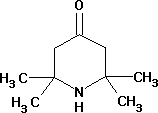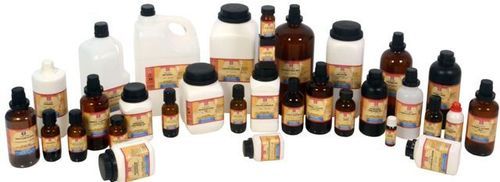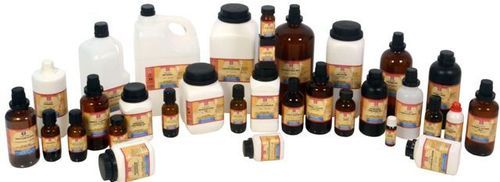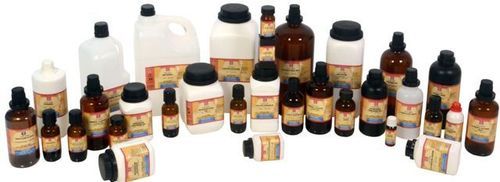Tetramethyl-4-piperidone
Product Details:
X
Product Description
LC5765 2,2,6,6-Tetramethyl-4-piperidonefor synthesis
| Order number | Packaging | Quantity | Price |
| AC32765 | Glass bottle | 100 g | 33.975 |
| Product information | |
| Synonyms | Triacetone amine, TAA |
| Hill Formula | C9H17NO |
| HS Code | 2933 39 99 |
| EC number | 212-554-2 |
| Molar mass | 155.23 g/mol |
| CAS number | 826-36-8 |
| Chemical and physical data | |
| Ignition temperature | 360 C DIN 51794 |
| Solubility | (20 C) soluble |
| Melting point | 32 - 35 C |
| Molar mass | 155.23 g/mol |
| Density | 0.92 g/cm3 (50 C) |
| Boiling point | 205 C (1013 hPa) |
| Vapor pressure | 0.3 hPa (20 C) |
| Flash point | 83 C |
| Refractive index | 1.452 (50 C, 589 nm) |
| Safety information according to GHS | |
| Hazard Statement(s) | H302: Harmful if swallowed. H314: Causes severe skin burns and eye damage. H317: May cause an allergic skin reaction. H412: Harmful to aquatic life with long lasting effects. |
| Precautionary Statement(s) | P273: Avoid release to the environment. P280: Wear protective gloves/ protective clothing/ eye protection/ face protection. P301 + P330 + P331: IF SWALLOWED: rinse mouth. Do NOT induce vomiting. P302 + P352: IF ON SKIN: Wash with plenty of soap and water. P305 + P351 + P338: IF IN EYES: Rinse cautiously with water for several minutes. Remove contact lenses, if present and easy to do. Continue rinsing. |
| Signal Word | Danger |
| Hazard Pictogram(s) |   |
| Storage class | 8 A Combustible substances, corrosive |
| WGK | WGK 1 slightly water endangering |
| Disposal | 3 Relatively unreactive organic reagents should be collected in container A. If halogenated, they should be collected in container B. For solid residues use container C. |
| Safety information | |
| R Phrase | R 22-34-43-52/53 Harmful if swallowed.Causes burns.May cause sensitization by skin contact.Harmful to aquatic organisms, may cause long-term adverse effects in the aquatic environment. |
| S Phrase | S 26-36/37/39-45-61 In case of contact with eyes, rinse immediately with plenty of water and seek medical advice.Wear suitable protective clothing, gloves and eye/face protection.In case of accident or if you feel unwell, seek medical advice immediately (show the label where possible).Avoid release to the environment. Refer to special instructions/ Safety data sheets. |
| Categories of danger | harmful, corrosive, sensitizing, dangerous for the environment |
| Hazard Symbol |  Corrosive Corrosive |
| Transport information | |
| Declaration (transport by sea) IMDG-Code | UN 3263 CORROSIVE SOLID, BASIC, ORGANIC, N.O.S.(2,2,6,6-TETRAMETHYL-4-PIPERIDON), 8, III, Segregation Group: 18 (Alkalis) |
| Declaration (transport by air) IATA-DGR | UN 3263 CORROSIVE SOLID, BASIC, ORGANIC, N.O.S.(2,2,6,6-TETRAMETHYL-4-PIPERIDON), 8, III |
| Toxicological data | |
| LD 50 oral | LD50 rat 1000 - 2000 mg/kg |
| LD 50 dermal | LD50 rat > 2000 mg/kg |
| Specifications | |
| Assay(GC, area%) | 96 % |
| Melting range - lower value | 32 C |
| - upper value | 35 C |
| Identity (IR-spectrum) | passes test |
Tell us about your requirement

Price:
Quantity
Select Unit
- 50
- 100
- 200
- 250
- 500
- 1000+
Additional detail
Mobile number
Email
Other Products in 'Laboratory Chemicals' category
We are deals in Lab Chemicals.
"Only deals in retail accepting orders upto 500ml only".
"Only deals in retail accepting orders upto 500ml only".
 |
ALPHA CHEMIKA
All Rights Reserved.(Terms of Use) Developed and Managed by Infocom Network Private Limited. |
 English
English Spanish
Spanish French
French German
German Italian
Italian Chinese (Simplified)
Chinese (Simplified) Japanese
Japanese Korean
Korean Arabic
Arabic Portuguese
Portuguese












